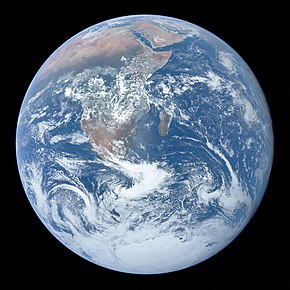Dunia
Dunia (pratiik: ![]() ) Suraj se duur tiisra planet hae. Ii Saur mandal (Solar System) ke chaar terrestrial planet me se ek hae. Iske matlab ii hae ki iske mass solid hae. Aur tiin terrestrial planet hae Mercury, Venus aur Mars.
) Suraj se duur tiisra planet hae. Ii Saur mandal (Solar System) ke chaar terrestrial planet me se ek hae. Iske matlab ii hae ki iske mass solid hae. Aur tiin terrestrial planet hae Mercury, Venus aur Mars.
 The Blue Marble, Apollo 17, December 1972 | |||||||||
| Designations | |||||||||
|---|---|---|---|---|---|---|---|---|---|
| The world, the globe, Sol III, Terra, Tellus, Gaia, Mother Earth | |||||||||
| Adjectives | Earthly, terrestrial, terran, tellurian | ||||||||
| Symbol | 🜨 and ♁ | ||||||||
| Orbital characteristics | |||||||||
| Epoch J2000 | |||||||||
| Aphelion | 152097597 km | ||||||||
| Perihelion | 147098450 km | ||||||||
| 149598023 km | |||||||||
| Eccentricity | 0.0167086 | ||||||||
| 365.256363004 d [ 1.00001742096 a ]j) | |||||||||
Average orbital speed | 29.7827 km/s | ||||||||
| 358.617° | |||||||||
| Inclination | Template:Ublist | ||||||||
| −11.26064° – J2000 ecliptic | |||||||||
| 2023-Jan-04[1] | |||||||||
| 114.20783° | |||||||||
| Satellites | 1, the Moon | ||||||||
| Physical characteristics | |||||||||
Mean radius | 6371.0 km | ||||||||
Equatorial radius | 6378.137 km | ||||||||
Polar radius | 6356.752 km | ||||||||
| Flattening | 1/298.257222101 (ETRS89) | ||||||||
| Circumference |
| ||||||||
| |||||||||
| Volume | 1.08321×1012 km3 | ||||||||
| Mass | 5.972168×1024 kg | ||||||||
Mean density | 5.513 g/cm3 | ||||||||
| 9.80665 m/s2 | |||||||||
| 0.3307 | |||||||||
| 11.186 km/s | |||||||||
1.0 d (24h 00 m 00s) | |||||||||
0.99726968 d (23h 56 m 4.100s) | |||||||||
Equatorial rotation velocity | 0.4651 km/s | ||||||||
| 23.4392811° | |||||||||
| Albedo | Template:Ublist | ||||||||
| Temperature | 255 K (−18 °C) (blackbody temperature)[4] | ||||||||
| |||||||||
| Surface equivalent dose rate | 0.274 μSv/h[5] | ||||||||
| −3.99 | |||||||||
| Atmosphere | |||||||||
Surface pressure | 101.325 kPa (at sea level) | ||||||||
| Composition by volume |
| ||||||||
Dunia me dher rakam ke perr aur janwar hae,[6] jisme admii bhi hae. Dunia universe ke ekke jagha hae jahan pe ii jaana jaawe hae ki jew hae.[7] Science se ii pataa lage hae ki dunia 4.5 billion saal pahile banaa rahaa.[8][9] Dunia me rahe waala chij dunia ke hawaa ke badal diin hae.[10]
Dunia ke 71% of surface khaara paani waala ocean se covered hae. [11] Baaki 29% me patthar waala jamiin continent aur island ke ruup me hae. Dunia Solar System ke aur planet se interact kare hae, particularly jaada kar ke Suraj aaur Chandarma se. Dunia, Suraj ke around orbit kare hae har 365.25 din me. Ek nachaai ke ek din bola jaawe hae aur ek orbit ke ek saal bolaa jaawe hae. Dunia ke lage khaali ek chandarma hae.
Dunia ke itihaas
badloDunia, aur duusra sab planet bhi, 4.6 billion saal pahile banaa rahaa.[12] Iske suruwaat Suraj se alag hae. Jab ke Suraj lagbhag puura hydrogen se banaa hae, sab planet duusra elements se banaa hae. Chhota planets, jaise ki Mercury, Venus, Dunia aur Mars puura garrhu element se banaa hae, lekin "gas giants" jaise ki Jupiter dher proportion me hydrogen aur helium se banaa hae.
Scientists log ii samjhr hae ki dunia ke Chandarma banaa rahaa jab dunia aur ek duusra planet (jiske kabh-kabhi Theia bola jaae hae) ek duusre ke dhakka maare rahin aur chandarma me duuno planet ke hissa hae.[13]
Dunia ke paani duusra jagha se aais hae. Jab comet aur asteroid nunia ke dhakka maarin tab usme se paani condense hoe ke samundar ban gais.. Lagbhag 3.6 billion saal pahile, dunia me jiu suruu bhais rahaa.[14]
Notes
badlo
References
badlo- ↑ Park, Ryan (9 May 2022). "Horizons Batch Call for 2023 Perihelion". NASA/JPL. Archived from the original on 3 July 2022. Retrieved 3 July 2022.
- ↑ World Geodetic System (WGS-84). Available online Archived 11 Maach 2020 at the Wayback Machine from National Geospatial-Intelligence Agency.
- ↑ meridionalEarth's circumference is almost exactly 40,000 km because the meter was calibrated on this measurement—more specifically, 1/10-millionth of the distance between the poles and the equator.
- ↑ "Atmospheres and Planetary Temperatures". American Chemical Society. 18 July 2013. Archived from the original on 27 January 2023. Retrieved 3 January 2023.
- ↑ United Nations Scientific Committee on the Effects of Atomic Radiation (2008). Sources and effects of ionizing radiation. New York: United Nations (published 2010). Table 1. ISBN 978-92-1-142274-0. http://www.unscear.org/unscear/en/publications/2008_1.html. Retrieved 9 November 2012.
- ↑ How Many Species are There on Earth. Harvard University. Retrieved on 28 Julai 2009.
- ↑ "BBC : The Earth". BBC. Archived from the original on 2001-08-16. Retrieved 2009-07-28.
- ↑ The age of the Earth in the twentieth century- a problem (mostly) solved. Geological Society, London, Special Publications. Retrieved on 28 Julai 2009.
- ↑ History of earth. Microsoft. Retrieved on 28 Julai 2009.
- ↑ Origins of life on Earth. Space.com. Archived from the original on 11 Juun 2001. Retrieved on 28 Julai 2009.
- ↑ Rover reveals Mars was once wet enough for life. Microsoft. Retrieved on 28 Julai 2009.
- ↑ Dalrymple, G. Brent (2001). "The age of the Earth in the twentieth century: a problem (mostly) solved". Special Publications, Geological Society of London 190 (1): 205–221. doi:10.1144/GSL.SP.2001.190.01.14.
- ↑ Canup, Robin M.; Asphaug, Erik (2001). "Origin of the Moon in a giant impact near the end of the Earth's formation". Nature (Nature.com) 412 (6848): 708–712. doi:10.1038/35089010. PMID 11507633. http://www.nature.com/nature/journal/v412/n6848/abs/412708a0.html. Retrieved 2009-07-28.
- ↑ "Earth life appeared on land 1.5 billion years earlier than previously thought". SpaceRef.com. 29 November 2000. Retrieved 2009-07-03.Template:Fix/category[dead link]
Duusra websites
badlo- "Solar Views". Calvin J. Hamilton. Retrieved 06-08-2009. Check date values in:
|accessdate=(help) - "NASA – Earth". Nasa. Archived from the original on 2005-03-10. Retrieved 06-08-2009. Check date values in:
|accessdate=(help)